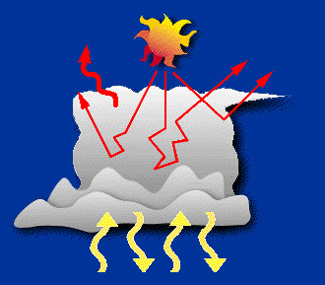|
A similar type of lag occurs on an annual basis.
The seasonal lag of temperature
is the amount of time between the highest incoming insolation and
highest temperature on an annual basis. For instance, in the midlatitudes the
highest angle that the sun makes with the surface, and thus the most intense heating, occurs around June 22nd. It isn't until about a month later that the highest
temperatures occur. The lag is often longer near a large body of water like
the Great Lakes or the ocean. A temperature lag of two months is not uncommon
for places located near large bodies of water.
Figure 5.4 Cloud effects on radiation Courtesy NASA Earth Observatory (Source) Clouds have an impact on the radiation balance and air temperature of a place. Clouds can block incoming solar radiation by reflection of their tops. Clouds also act to diffuse light as it penetrates towards the surface. Both of these would act to cool the atmosphere. Clouds and water vapor are good absorbers of longwave radiation emitted by the earth's surface too. You've probably noticed that the warmest evenings tend to be when we have a heavy cover of clouds. These clouds absorb the radiation emitted by the earth and radiate it back down toward the earth's surface, warming the air. The coldest evenings occur during cloudless conditions. The lack of clouds in the desert creates large daily temperature ranges. During the day, sunlight streams to the earth's surface heating it to very high temperatures. Near surface air temperatures are very high as a result. At night, the absence of clouds allows emitted longwave radiation to escape to space causing the surface to cool and the air above to do so as well. The atmosphere is also heated by the exchange of sensible heat between the surface and the air above. Sensible heat is transferred into the air by conduction and convection. Heat is most efficiently moved by turbulent eddies, or swirls of vertically moving air. The initial transfer is due to the presence of a temperature gradient between the surface and the air. If the surface of the earth is warmer than the air above, heat will be transferred upwards raising the temperature of the air. If the air is warmer than the surface, heat will be transferred towards the surface, thus cooling the air. The lag of temperature behind incoming radiation is also a result of the time it takes for sensible heat to transferred upwards. |

